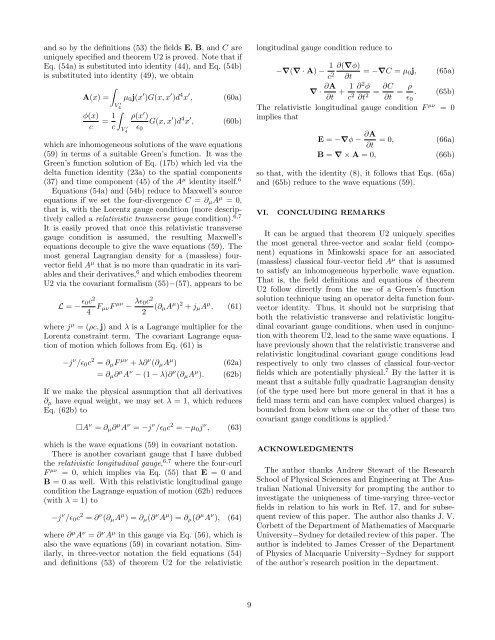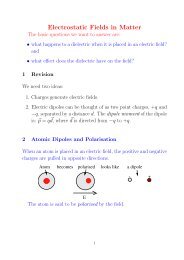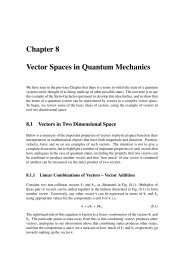Three-vector and scalar field identities and uniqueness theorems in ...
Three-vector and scalar field identities and uniqueness theorems in ...
Three-vector and scalar field identities and uniqueness theorems in ...
Create successful ePaper yourself
Turn your PDF publications into a flip-book with our unique Google optimized e-Paper software.
<strong>and</strong> so by the def<strong>in</strong>itions (53) the <strong>field</strong>s E, B, <strong>and</strong> C areuniquely specified <strong>and</strong> theorem U2 is proved. Note that ifEq. (54a) is substituted <strong>in</strong>to identity (44), <strong>and</strong> Eq. (54b)is substituted <strong>in</strong>to identity (49), we obta<strong>in</strong>∫A(x) = µ 0 j(x ′ )G(x, x ′ )d 4 x ′ , (60a)φ(x)c= 1 cV 4′∫V ′4ρ(x ′ )ɛ 0G(x, x ′ )d 4 x ′ , (60b)which are <strong>in</strong>homogeneous solutions of the wave equations(59) <strong>in</strong> terms of a suitable Green’s function. It was theGreen’s function solution of Eq. (17b) which led via thedelta function identity (23a) to the spatial components(37) <strong>and</strong> time component (45) of the A µ identity itself. 6Equations (54a) <strong>and</strong> (54b) reduce to Maxwell’s sourceequations if we set the four-divergence C = ∂ µ A µ = 0,that is, with the Lorentz gauge condition (more descriptivelycalled a relativistic transverse gauge condition). 6,7It is easily proved that once this relativistic transversegauge condition is assumed, the result<strong>in</strong>g Maxwell’sequations decouple to give the wave equations (59). Themost general Lagrangian density for a (massless) four<strong>vector</strong><strong>field</strong> A µ that is no more than quadratic <strong>in</strong> its variables<strong>and</strong> their derivatives, 6 <strong>and</strong> which embodies theoremU2 via the covariant formalism (55)−(57), appears to beL = − ɛ 0c 24 F µνF µν − λɛ 0c 22(∂ µ A µ ) 2 + j µ A µ , (61)where j µ = (ρc, j) <strong>and</strong> λ is a Lagrange multiplier for theLorentz constra<strong>in</strong>t term. The covariant Lagrange equationof motion which follows from Eq. (61) is−j ν /ɛ 0 c 2 = ∂ µ F µν + λ∂ ν (∂ µ A µ )(62a)= ∂ µ ∂ µ A ν − (1 − λ)∂ ν (∂ µ A µ ). (62b)If we make the physical assumption that all derivatives∂ µ have equal weight, we may set λ = 1, which reducesEq. (62b) to□A ν = ∂ µ ∂ µ A ν = −j ν /ɛ 0 c 2 = −µ 0 j ν , (63)which is the wave equations (59) <strong>in</strong> covariant notation.There is another covariant gauge that I have dubbedthe relativistic longitud<strong>in</strong>al gauge, 6,7 where the four-curlF µν = 0, which implies via Eq. (55) that E = 0 <strong>and</strong>B = 0 as well. With this relativistic longitud<strong>in</strong>al gaugecondition the Lagrange equation of motion (62b) reduces(with λ = 1) to−j ν /ɛ 0 c 2 = ∂ ν (∂ µ A µ ) = ∂ µ (∂ ν A µ ) = ∂ µ (∂ µ A ν ), (64)where ∂ µ A ν = ∂ ν A µ <strong>in</strong> this gauge via Eq. (56), which isalso the wave equations (59) <strong>in</strong> covariant notation. Similarly,<strong>in</strong> three-<strong>vector</strong> notation the <strong>field</strong> equations (54)<strong>and</strong> def<strong>in</strong>itions (53) of theorem U2 for the relativisticlongitud<strong>in</strong>al gauge condition reduce to−∇(∇ · A) − 1 ∂(∇φ)c 2 = −∇C = µ 0 j,∂t(65a)∇ · ∂A∂t + 1 ∂ 2 φc 2 ∂t 2 = ∂C∂t = ρ .ɛ 0(65b)The relativistic longitud<strong>in</strong>al gauge condition F µν = 0implies thatE = −∇φ − ∂A∂t = 0,B = ∇ × A = 0,(66a)(66b)so that, with the identity (8), it follows that Eqs. (65a)<strong>and</strong> (65b) reduce to the wave equations (59).VI.CONCLUDING REMARKSIt can be argued that theorem U2 uniquely specifiesthe most general three-<strong>vector</strong> <strong>and</strong> <strong>scalar</strong> <strong>field</strong> (component)equations <strong>in</strong> M<strong>in</strong>kowski space for an associated(massless) classical four-<strong>vector</strong> <strong>field</strong> A µ that is assumedto satisfy an <strong>in</strong>homogeneous hyperbolic wave equation.That is, the <strong>field</strong> def<strong>in</strong>itions <strong>and</strong> equations of theoremU2 follow directly from the use of a Green’s functionsolution technique us<strong>in</strong>g an operator delta function four<strong>vector</strong>identity. Thus, it should not be surpris<strong>in</strong>g thatboth the relativistic transverse <strong>and</strong> relativistic longitud<strong>in</strong>alcovariant gauge conditions, when used <strong>in</strong> conjunctionwith theorem U2, lead to the same wave equations. Ihave previously shown that the relativistic transverse <strong>and</strong>relativistic longitud<strong>in</strong>al covariant gauge conditions leadrespectively to only two classes of classical four-<strong>vector</strong><strong>field</strong>s which are potentially physical. 7 By the latter it ismeant that a suitable fully quadratic Lagrangian density(of the type used here but more general <strong>in</strong> that it has a<strong>field</strong> mass term <strong>and</strong> can have complex valued charges) isbounded from below when one or the other of these twocovariant gauge conditions is applied. 7ACKNOWLEDGMENTSThe author thanks Andrew Stewart of the ResearchSchool of Physical Sciences <strong>and</strong> Eng<strong>in</strong>eer<strong>in</strong>g at The AustralianNational University for prompt<strong>in</strong>g the author to<strong>in</strong>vestigate the <strong>uniqueness</strong> of time-vary<strong>in</strong>g three-<strong>vector</strong><strong>field</strong>s <strong>in</strong> relation to his work <strong>in</strong> Ref. 17, <strong>and</strong> for subsequentreview of this paper. The author also thanks J. V.Corbett of the Department of Mathematics of MacquarieUniversity−Sydney for detailed review of this paper. Theauthor is <strong>in</strong>debted to James Cresser of the Departmentof Physics of Macquarie University−Sydney for supportof the author’s research position <strong>in</strong> the department.9
















